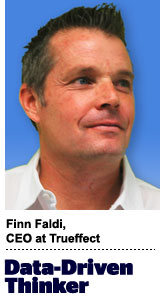 “Data-Driven Thinking” is written by members of the media community and contains fresh ideas on the digital revolution in media.
“Data-Driven Thinking” is written by members of the media community and contains fresh ideas on the digital revolution in media.
Today’s column is written by Finn Faldi, CEO at Trueffect.
The Internet of Things (IoT) exploded onto the tech scene last year and scored major attention at this year’s Consumer Electronics Show. The IoT market is huge, with a projected reach of $19 trillion by 2020.
There are practically limitless opportunities to harness the IoT to capture the hearts and minds of consumers in new ways. But what makes the IoT exciting is how suddenly every connected “thing” will have its own data ecosystem, including more streams of first-party data.
IoT brings data to a whole new level, accelerating the reams of data flowing to brands from smart brand-to-device and device-to-device interactions. Therefore, it won’t be long before we see automotive, appliance, consumer packaged goods and a host of other data-driven industries follow similar monetization strategies. As a result, the roles that advertisers’ partners will play – from digital marketing platforms to data providers – will dramatically change as digital strategies shift.
Big Data’s New Chapter
The IoT has incredible breadth and depth in both consumer and industrial applications – the connected home, connected cars, wearables, sensors, LEDs and long-haul trucking applications just barely scratch the surface. For brand advertisers, these new connection points, estimated to reach 30 billion devices by 2020, create a playground for digital innovation while expanding the universe of digital data.
In the classic IoT example, a refrigerator senses the food inside and triggers a cascade of customizable events, sending the owner a smartphone alert to buy milk or suggestions for Kraft-branded dinner recipes. That’s just a simple example of a single direct relationship between a consumer’s fridge and his smartphone.
In a more complicated, on-the-go example, you’re playing tennis in the park, wearing a Nike shirt with an activated tag. The smart athletic shirt recognizes you are in a park and sends recommendations to your smartphone offers for Gatorade deals, nearby lunch spots or places to rest after your game. This is revolutionary. A consumer now can receive immediately redeemable offers and relevant information in real time just by wearing a connected product.
It’s easy to see how brands’ imaginations can run wild. Now there are new channels and intimate moments in which marketers can leverage first-party data and extend their stories at more opportune times. The benefits of the influx of primary data in advertising are limitless.
How Will Roles Shift?
“We’re at the very early stages of this market and we already have billions of data points coming in,” said Kevin Meagher, vice president and general manager of Lowe’s Smart Home business unit. “I’ll be frank with you – we don’t have a clue what to do with it right now, but we’ll put it aside and figure out what to do with it later.”
At IoT’s nascent stage, Meagher’s sentiment is not uncommon. What do we do with all this data is coming in, who will have access to it and to what extent will consumers understand how it is being used? Understanding the answers is key to performance-based media and, more specifically, performance-focused marketers.
When a consumer buys a refrigerator from Kenmore, the company captures her or his information in its database to leverage for its internal marketing programs. With the rise of IoT and devices that can connect with other manufacturers, customer data can also serve as valuable target information for another brand.
So not only does Kenmore become a marketing company in a sense by selling space and potentially data to other advertisers, it also becomes a first-party data management player in a more complex way than ever before. Kenmore can create its own network with its own first-party ad server, a customer relationship management partner and a media planning department, supporting a universe of customers and opportunities while evolving its role in IoT.
Kenmore’s example, extended to the entire universe of product manufacturers, starts to signify a seismic shift in the broader marketing ecosystem as brands’ revenue lines expand into publisher and agency territories. While brands will have green fields of opportunity that leverage the influx of IoT data, publishers and agencies will need to explore new value add offerings to stay competitive.
Despite IoT Challenges, Pioneering Opportunities Ahead
The industry’s data landscape will shift dramatically in the coming years. With no infrastructure or clear standards for IoT data yet established, marketers will experience growing pains navigating new potential opportunities and striking a balance between critical issues, such as privacy and security. Despite the challenges ahead, there are immense benefits from IoT data that will help brand manufacturers, marketers, consumers and everyone in between increase their value proposition to the marketplace.
Follow Trueffect (@Trueffect_Tweet) and AdExchanger (@adexchanger) on Twitter.













